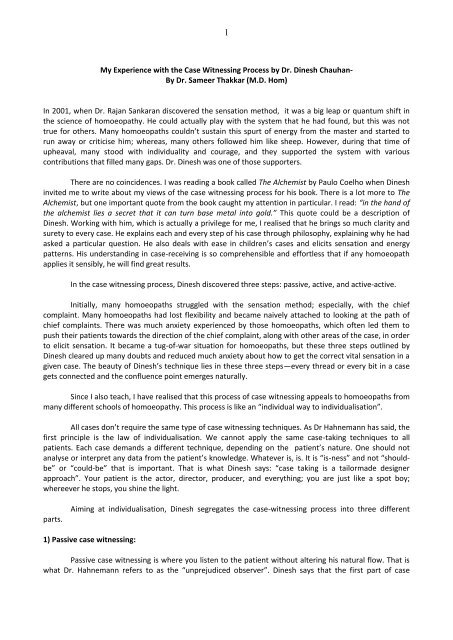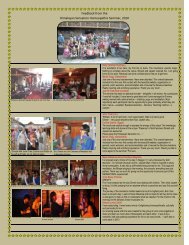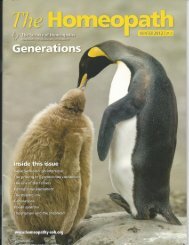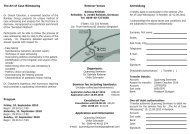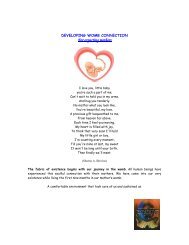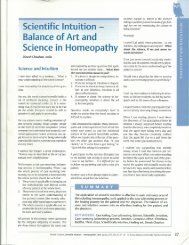Review About the book and author by Dr. Sameer Thakkar
Review About the book and author by Dr. Sameer Thakkar
Review About the book and author by Dr. Sameer Thakkar
You also want an ePaper? Increase the reach of your titles
YUMPU automatically turns print PDFs into web optimized ePapers that Google loves.
1<br />
My Experience with <strong>the</strong> Case Witnessing Process <strong>by</strong> <strong>Dr</strong>. Dinesh Chauhan-<br />
By <strong>Dr</strong>. <strong>Sameer</strong> <strong>Thakkar</strong> (M.D. Hom)<br />
In 2001, when <strong>Dr</strong>. Rajan Sankaran discovered <strong>the</strong> sensation method, it was a big leap or quantum shift in<br />
<strong>the</strong> science of homoeopathy. He could actually play with <strong>the</strong> system that he had found, but this was not<br />
true for o<strong>the</strong>rs. Many homoeopaths couldn’t sustain this spurt of energy from <strong>the</strong> master <strong>and</strong> started to<br />
run away or criticise him; whereas, many o<strong>the</strong>rs followed him like sheep. However, during that time of<br />
upheaval, many stood with individuality <strong>and</strong> courage, <strong>and</strong> <strong>the</strong>y supported <strong>the</strong> system with various<br />
contributions that filled many gaps. <strong>Dr</strong>. Dinesh was one of those supporters.<br />
There are no coincidences. I was reading a <strong>book</strong> called The Alchemist <strong>by</strong> Paulo Coelho when Dinesh<br />
invited me to write about my views of <strong>the</strong> case witnessing process for his <strong>book</strong>. There is a lot more to The<br />
Alchemist, but one important quote from <strong>the</strong> <strong>book</strong> caught my attention in particular. I read: “in <strong>the</strong> h<strong>and</strong> of<br />
<strong>the</strong> alchemist lies a secret that it can turn base metal into gold.” This quote could be a description of<br />
Dinesh. Working with him, which is actually a privilege for me, I realised that he brings so much clarity <strong>and</strong><br />
surety to every case. He explains each <strong>and</strong> every step of his case through philosophy, explaining why he had<br />
asked a particular question. He also deals with ease in children’s cases <strong>and</strong> elicits sensation <strong>and</strong> energy<br />
patterns. His underst<strong>and</strong>ing in case-receiving is so comprehensible <strong>and</strong> effortless that if any homoeopath<br />
applies it sensibly, he will find great results.<br />
In <strong>the</strong> case witnessing process, Dinesh discovered three steps: passive, active, <strong>and</strong> active-active.<br />
Initially, many homoeopaths struggled with <strong>the</strong> sensation method; especially, with <strong>the</strong> chief<br />
complaint. Many homoeopaths had lost flexibility <strong>and</strong> became naively attached to looking at <strong>the</strong> path of<br />
chief complaints. There was much anxiety experienced <strong>by</strong> those homoeopaths, which often led <strong>the</strong>m to<br />
push <strong>the</strong>ir patients towards <strong>the</strong> direction of <strong>the</strong> chief complaint, along with o<strong>the</strong>r areas of <strong>the</strong> case, in order<br />
to elicit sensation. It became a tug-of-war situation for homoeopaths, but <strong>the</strong>se three steps outlined <strong>by</strong><br />
Dinesh cleared up many doubts <strong>and</strong> reduced much anxiety about how to get <strong>the</strong> correct vital sensation in a<br />
given case. The beauty of Dinesh’s technique lies in <strong>the</strong>se three steps—every thread or every bit in a case<br />
gets connected <strong>and</strong> <strong>the</strong> confluence point emerges naturally.<br />
Since I also teach, I have realised that this process of case witnessing appeals to homoeopaths from<br />
many different schools of homoeopathy. This process is like an “individual way to individualisation”.<br />
All cases don’t require <strong>the</strong> same type of case witnessing techniques. As <strong>Dr</strong> Hahnemann has said, <strong>the</strong><br />
first principle is <strong>the</strong> law of individualisation. We cannot apply <strong>the</strong> same case-taking techniques to all<br />
patients. Each case dem<strong>and</strong>s a different technique, depending on <strong>the</strong> patient’s nature. One should not<br />
analyse or interpret any data from <strong>the</strong> patient’s knowledge. Whatever is, is. It is “is-ness” <strong>and</strong> not “shouldbe”<br />
or “could-be” that is important. That is what Dinesh says: “case taking is a tailormade designer<br />
approach”. Your patient is <strong>the</strong> actor, director, producer, <strong>and</strong> everything; you are just like a spot boy;<br />
whereever he stops, you shine <strong>the</strong> light.<br />
parts.<br />
Aiming at individualisation, Dinesh segregates <strong>the</strong> case-witnessing process into three different<br />
1) Passive case witnessing:<br />
Passive case witnessing is where you listen to <strong>the</strong> patient without altering his natural flow. That is<br />
what <strong>Dr</strong>. Hahnemann refers to as <strong>the</strong> “unprejudiced observer”. Dinesh says that <strong>the</strong> first part of case
2<br />
witnessing is very important. To find <strong>the</strong> patient’s unique centre, we need to create a silent space, <strong>and</strong>, for<br />
that, we need to be passive. Dinesh’s emphasis in passive case witnessing, which is <strong>the</strong> first part, is to<br />
achieve <strong>the</strong> goal of individualisation. He puts stress on “being passive, while at <strong>the</strong> same time being alert”.<br />
Passive, so that our knowledge doesn’t come in between, <strong>and</strong> alert, so that you receive everything from <strong>the</strong><br />
patient without shifting his natural flow. Whatever is inside should come outside in <strong>the</strong> way that <strong>the</strong><br />
patient wants to tell you; <strong>the</strong>refore, whatever questions you pose should not alter this flow. In <strong>the</strong> passive<br />
phase, we have to take note of all <strong>the</strong> characteristic verbal <strong>and</strong> non-verbal expressions of <strong>the</strong> patient, as<br />
well as what <strong>the</strong> patient is knowingly or unknowingly keeping in <strong>the</strong> centre.<br />
We have to remain passive because, to begin with, a patient will more often than not express <strong>the</strong><br />
common, conscious human talk all jumbled up with a little non-human / nonsense talk. The non-human<br />
element initially comes at <strong>the</strong> spur of <strong>the</strong> moment; as <strong>the</strong> case advances, it becomes more <strong>and</strong> more<br />
intense. Finally, at <strong>the</strong> end, it comes to <strong>the</strong> forefront <strong>and</strong> draws everything closer toge<strong>the</strong>r.<br />
Staying alert <strong>and</strong> passive helps as this gives direction to a case.<br />
When we start to get active, we focus on <strong>the</strong> focus of <strong>the</strong> patient. Many homoeopaths ask this<br />
question: “Which word should I pick up once I have entered <strong>the</strong> active phase?” There are so many words<br />
that we can feel lost in <strong>the</strong> jungle. Dinesh suggests that we should scientifically pick up that which is in <strong>the</strong><br />
centre, which comes up again <strong>and</strong> again in two-to-three different areas not related to each o<strong>the</strong>r <strong>and</strong> in a<br />
different time zone. This is what Dinesh defines as <strong>the</strong> focus of <strong>the</strong> case. If a patient expresses something<br />
that is present in his chief complaint or dreams, <strong>and</strong> if he speaks about <strong>the</strong> same thing in relation to his<br />
childhood, it means this is <strong>the</strong> focus of <strong>the</strong> case.<br />
If a patient gets stuck halfway, you can ask open-ended, non-leading questions, so that <strong>the</strong> flow does<br />
not change. Dinesh maintains flexibility in applying <strong>the</strong> method. There are some cases where <strong>the</strong> patient’s<br />
level of experience is very low. For instance, whereever <strong>the</strong> pathology is high or <strong>the</strong> level of experience is<br />
low, in such cases, Dinesh suggests, we should become active from <strong>the</strong> beginning <strong>and</strong> scrutinise different<br />
subconscious areas (dreams, childhood, imagination, <strong>and</strong> incidents that have had a deep impact on <strong>the</strong><br />
patient). The aim here is to find <strong>the</strong> focus of <strong>the</strong> case in all <strong>the</strong>se areas, so that one is very sure of <strong>the</strong> focus<br />
<strong>and</strong> can become active with <strong>the</strong> focus.<br />
2) Active case witnessing:<br />
In this part of case taking, you ask questions leading in a particular direction (which <strong>the</strong> patient has,<br />
consciously or unconsciously, decided for us). Still, you remain open to where your patient will fur<strong>the</strong>r lead<br />
you. The questions that you select from <strong>the</strong> first part must activate <strong>the</strong> patient’s imagination. This inquiry,<br />
more often than not, will link <strong>and</strong> envelop <strong>the</strong> o<strong>the</strong>r irrelevant facets, too. During <strong>the</strong> process, we see what<br />
is known as “internal consistency.” If not, <strong>the</strong>n <strong>the</strong> physician will allow fur<strong>the</strong>r voluntary narration <strong>and</strong> only<br />
<strong>the</strong>n be at liberty to ask more precise questions, after picking up <strong>the</strong> vague / irrelevant aspects from <strong>the</strong><br />
new information. In this way, he must first completely underst<strong>and</strong> <strong>the</strong> subconscious aspect before going<br />
beyond it into <strong>the</strong> complete unconscious.<br />
Often, every aspect of <strong>the</strong> first part starts to unite everything. Ano<strong>the</strong>r way of putting it is that <strong>the</strong><br />
many gaps in <strong>the</strong> case get filled up <strong>and</strong> <strong>the</strong> complete pattern emerges at <strong>the</strong> subconscious level; <strong>the</strong>n, <strong>the</strong><br />
confluence point (<strong>the</strong> sensation pattern) will start appearing. You can say that you reached very close to <strong>the</strong><br />
global sensation.<br />
3) The Active-Active case witnessing process:
3<br />
The aim of <strong>the</strong> third part of <strong>the</strong> active focus is to reach at <strong>the</strong> unconscious, pure self—<strong>the</strong><br />
quintessence or source level of <strong>the</strong> case. Here, you start with <strong>the</strong> focus that you established after you had<br />
finished <strong>the</strong> second part. Now you know where <strong>the</strong> ultimate energy pattern lies in <strong>the</strong> case.<br />
The physician needs to identify <strong>the</strong> internal consistency in <strong>the</strong> total information, only <strong>the</strong>n is <strong>the</strong><br />
inquiry complete. Once <strong>the</strong> unconscious has been unfolded <strong>and</strong> encountered, <strong>the</strong> narration on <strong>the</strong> part of<br />
<strong>the</strong> patient more often than not gains a kind of momentum similar to that of a pure self. The whole<br />
phenomenon of narration gears <strong>the</strong> individual’s psyche up to reach <strong>the</strong> point where <strong>the</strong> “subconscious<br />
inhibiting <strong>the</strong> unconscious” is itself inhibited.<br />
Here, <strong>the</strong> physician plays an active role <strong>and</strong> does not allow his patients to w<strong>and</strong>er anywhere o<strong>the</strong>r<br />
<strong>the</strong>n toward <strong>the</strong> final pattern. Now, no story, no situation, <strong>and</strong> no thought can block any of <strong>the</strong> roads which<br />
lead your patient back to conscious levels. At this final point, you can ask <strong>the</strong> patient to fur<strong>the</strong>r describe <strong>the</strong><br />
process <strong>and</strong> <strong>the</strong> whole phenomenon step <strong>by</strong> step. Once <strong>the</strong> patient has finished with <strong>the</strong> process, ask him<br />
to describe everything once again until he doesn’t add any new information.<br />
In some cases, as a result of close contact with his unconscious self, <strong>the</strong> patient may even mention<br />
<strong>the</strong> details or finest qualities of <strong>the</strong> source which he is going to receive. If he does, it is just <strong>the</strong> icing on <strong>the</strong><br />
cake! Thus, in <strong>the</strong> active <strong>and</strong> active-active, <strong>the</strong> flow is directed to one specific direction—towards<br />
underst<strong>and</strong>ing <strong>the</strong> complete altered pattern, with <strong>the</strong> natural language of <strong>the</strong> substance that <strong>the</strong> patient is<br />
going to receive.<br />
Once <strong>the</strong> process is complete, you take <strong>the</strong> patient to a level where he temporarily becomes aware<br />
of his entire problem / phenomenon right in front of you; that is <strong>the</strong> level where <strong>the</strong> healing pause is given<br />
<strong>by</strong> you.<br />
This process of case witnessing has helped me greatly, <strong>and</strong> I use it in all my cases. Through this<br />
process, which does not allow <strong>the</strong> conscious mind to take over, most of my patients (including<br />
homoeopaths) reach <strong>the</strong> core of <strong>the</strong> disturbance <strong>and</strong> are able to describe <strong>the</strong> source language; some also<br />
give <strong>the</strong> name of it.<br />
<strong>Dr</strong>. <strong>Sameer</strong> <strong>Thakkar</strong> (M.D. Homoepathy)<br />
Ahamdabad


